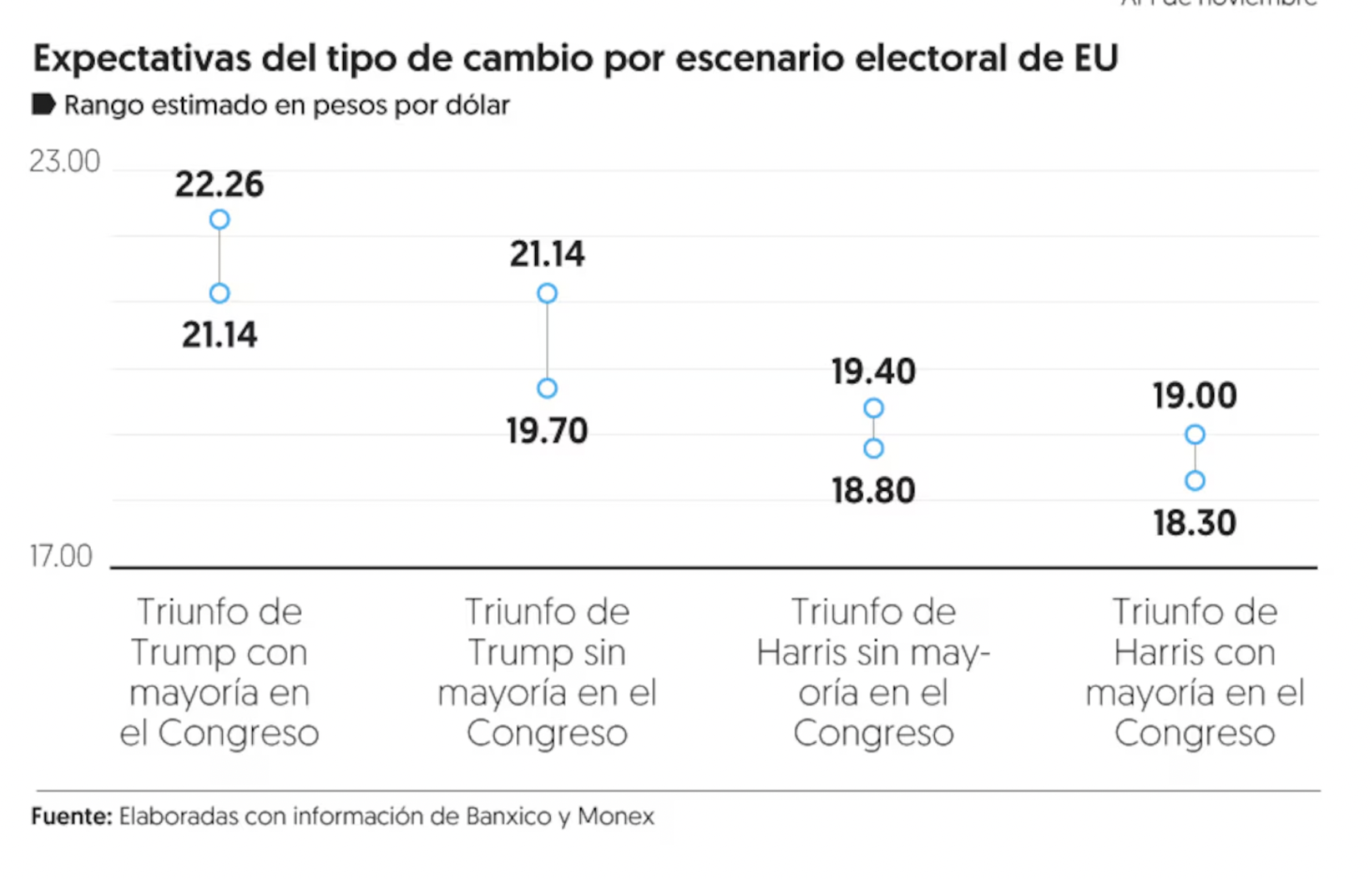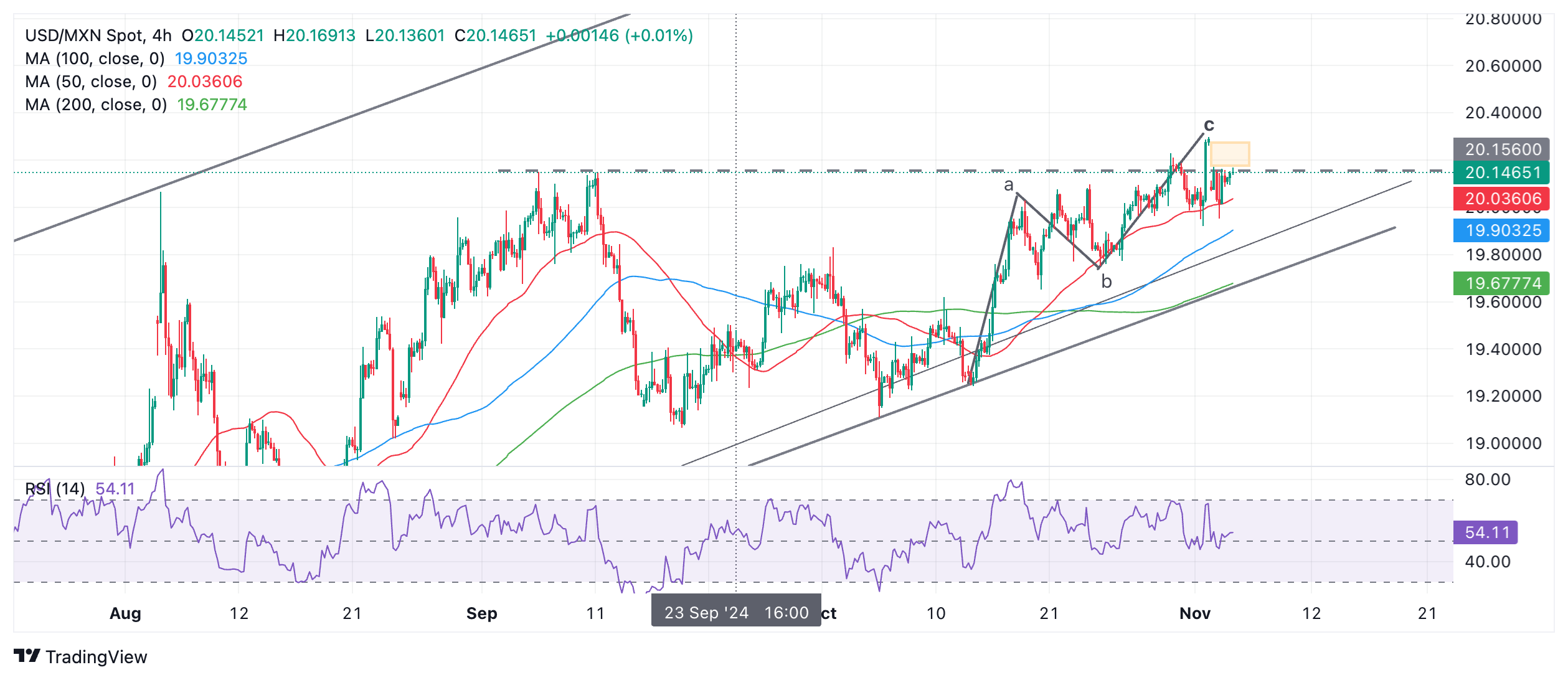- Analytics
- News and Tools
- Market News
- Mexican Peso trades sideways ahead of US presidential election result
Mexican Peso trades sideways ahead of US presidential election result
- The Mexican Peso trades in a range as traders await news of the US presidential election.
- The winner could have a significant impact on the Peso in the days to come.
- Technically, USD/MXN continues to trade below the opening chart gap it formed when it broke lower on Monday.
The Mexican Peso (MXN) fluctuates between tepid gains and losses on Tuesday as traders await with bated breath the outcome of the US presidential election, an important driver of the Peso over the coming days.
If the Democrat nominee Kamala Harris wins, it is expected to be positive for the Peso, whilst if the Republican nominee Donald Trump is victorious, the impact is likely to be negative, according to financial news website El Financiero. The difference is due to Trump’s threat to place tariffs on Mexican imports.
The highly-esteemed election forecaster 538.com indicates the probability of Vice President Harris winning is 50%, whilst former President Donald Trump has a 49% chance of victory and a 1% chance of no overall winner. Over the last 24 hours, Harris has snuck into the lead after lagging Trump for several days. This may explain the Peso’s strengthening across its main pairs on Monday.
Mexican Peso: Four US presidential election scenarios
The Mexican Peso exchange rate with the US Dollar (USD) is foreseen to fluctuate between a low of 18.30 and a high of 22.26 depending on the outcome of the US presidential election, says El Financiero.
The graphic below shows the USD/MXN in four possible US presidential election scenarios.
In the case of Harris winning and the Democrats securing a majority in Congress, the Peso is likely to strengthen to between 18.30 and 19.00 against the USD.
If Trump wins with a Republican majority in Congress, the Peso is likely to fall to between 21.14 and 22.26 to the US Dollar.
If Kamala Harris wins the presidency but fails to get a majority in Congress, USD/MXN is likely to fluctuate between 18.80 and 19.40.
If Trump wins without a Republican majority in Congress, the pair is likely to end up in a range between 19.70 and 21.14.
Mexican Peso prepares for the Supreme Court vs. Sheinbaum
The Mexican Peso could face material risk from domestic political factors in the coming days as the Mexican Supreme Court decides on Tuesday whether a controversial law to reform the legal system is unconstitutional.
The reform – which has already been voted through parliament – seeks the election of judges by popular vote rather than appointment. Supporters say it will eliminate corruption. Critics argue it will undermine the independence of the judiciary and hand the government too much power.
Mexican President Claudia Sheinbaum said she would await the Supreme Court's decision but added, “It has to be made very clear that eight justices cannot be above the people,” at a press conference on Monday.
Supreme Court judge and critic of the reform Juan Luis González Alcántara recently proposed a compromise that would limit the election of judges to only those of the Supreme Court and not the thousands of lower court judges in Mexico.
Anticipating delays to its proposed reforms, the Mexican parliament recently passed another law that prevents the courts from blocking the implementation of legislation. So, even if the Supreme Court decides against the implementation of the reform on Tuesday, the government may just ignore their decision and press ahead regardless.
This would lead Mexico into uncharted territory constitutionally, according to experts, with potential implications for the economy and the foreign investor confidence in the country’s courts going forward.
“This will lead to a constitutional crisis of a kind we have not seen for the duration of the 1917 constitution,” Olvera Rangel, a professor of law at the Universidad Nacional Autónoma de México (UNAM), was quoted as saying in The Guardian.
Technical Analysis: USD/MXN leaves gap open as it ranges
USD/MXN trades below the gap down it formed on Monday (orange shaded rectangle on the chart below). The gap formed after the pair completed a bullish Measured Move, or “abc” pattern last week.
USD/MXN 4-hour Chart
USD/MXN is still probably in an overall uptrend on a short, medium and long-term basis. Further, it is trading in a bullish rising channel. Given the technical dictum “the trend is your friend,” the odds, therefore, favor a continuation higher.
Further, gaps do not tend to remain open for long, according to technical analysis, and this suggests a mild bias for prices to rise and close the gap over coming sessions.
Mexican Peso FAQs
The Mexican Peso (MXN) is the most traded currency among its Latin American peers. Its value is broadly determined by the performance of the Mexican economy, the country’s central bank’s policy, the amount of foreign investment in the country and even the levels of remittances sent by Mexicans who live abroad, particularly in the United States. Geopolitical trends can also move MXN: for example, the process of nearshoring – or the decision by some firms to relocate manufacturing capacity and supply chains closer to their home countries – is also seen as a catalyst for the Mexican currency as the country is considered a key manufacturing hub in the American continent. Another catalyst for MXN is Oil prices as Mexico is a key exporter of the commodity.
The main objective of Mexico’s central bank, also known as Banxico, is to maintain inflation at low and stable levels (at or close to its target of 3%, the midpoint in a tolerance band of between 2% and 4%). To this end, the bank sets an appropriate level of interest rates. When inflation is too high, Banxico will attempt to tame it by raising interest rates, making it more expensive for households and businesses to borrow money, thus cooling demand and the overall economy. Higher interest rates are generally positive for the Mexican Peso (MXN) as they lead to higher yields, making the country a more attractive place for investors. On the contrary, lower interest rates tend to weaken MXN.
Macroeconomic data releases are key to assess the state of the economy and can have an impact on the Mexican Peso (MXN) valuation. A strong Mexican economy, based on high economic growth, low unemployment and high confidence is good for MXN. Not only does it attract more foreign investment but it may encourage the Bank of Mexico (Banxico) to increase interest rates, particularly if this strength comes together with elevated inflation. However, if economic data is weak, MXN is likely to depreciate.
As an emerging-market currency, the Mexican Peso (MXN) tends to strive during risk-on periods, or when investors perceive that broader market risks are low and thus are eager to engage with investments that carry a higher risk. Conversely, MXN tends to weaken at times of market turbulence or economic uncertainty as investors tend to sell higher-risk assets and flee to the more-stable safe havens.
© 2000-2024. All rights reserved.
This site is managed by Teletrade D.J. LLC 2351 LLC 2022 (Euro House, Richmond Hill Road, Kingstown, VC0100, St. Vincent and the Grenadines).
The information on this website is for informational purposes only and does not constitute any investment advice.
The company does not serve or provide services to customers who are residents of the US, Canada, Iran, The Democratic People's Republic of Korea, Yemen and FATF blacklisted countries.
Making transactions on financial markets with marginal financial instruments opens up wide possibilities and allows investors who are willing to take risks to earn high profits, carrying a potentially high risk of losses at the same time. Therefore you should responsibly approach the issue of choosing the appropriate investment strategy, taking the available resources into account, before starting trading.
Use of the information: full or partial use of materials from this website must always be referenced to TeleTrade as the source of information. Use of the materials on the Internet must be accompanied by a hyperlink to teletrade.org. Automatic import of materials and information from this website is prohibited.
Please contact our PR department if you have any questions or need assistance at pr@teletrade.global.

















